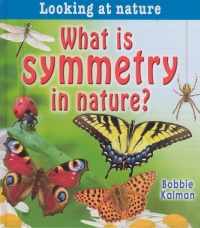| ________________
CM . . . . Volume XVII Number 16. . . .December 17, 2010. 
 |
What Is Symmetry in Nature? (Looking at Nature).
Bobbie Kalman.
St. Catharines, ON: Crabtree, 2011.
24 pp., pbk. & hc., $7.95 (pbk.) $18.36 (RLB.).
ISBN 978-0-7787-3347-8 (pbk.), ISBN 978-0-7787-3327-0 (RLB.).
Subject Headings:
Symmetry-Juvenile literature.
Preschool-grade 2 / Ages 4-7.
Review by Sherry Faller.
****/4
|
| |
 |
What Are Opposites in Nature? (Looking at Nature).
Bobbie Kalman.
St. Catharines, ON: Crabtree, 2011.
24 pp., pbk. & hc., $7.95 (pbk.) $18.36 (RLB.).
ISBN 978-0-7787-3346-1 (pbk.), ISBN 978-0-7787-3326-3 (RLB.).
Subject Headings:
Nature-Juvenile literature.
Polarity-Juvenile literature.
Preschool-grade 2 / Ages 4-7.
Review by Sherry Faller.
****/4
|
| |
|

excerpt:
Many things in nature have five or more equal parts. You can draw five or more lines of symmetry on them. You can spin them around, too, and the symmetry will not change. (From What is Symmetry in Nature?)
Bobbie Kalman and her team have produced two delightful book, part of the "Looking at Nature" series, that will engage, entertain and challenge young readers. Teachers from preschool to grade 2 will find these resources exceptionally well researched and displayed.
The bright and boldly coloured photos illustrate the concepts in the text. The large font text offers a great nonfiction reading source for young readers. Children will also enjoy the quizzes found in each section. The answers are upside down on the same page. The "Words to Know" section at the back of the book is very child-friendly and incorporates the same photos shown on the pages listed. The bolded index is an excellent first look at how to use one.
i>What is Symmetry in Nature? illustrates different types of symmetry, like 5-line, 6-line, diagonal, vertical and horizontal. Examples of items that are symmetrical but with differences are also shown.
What are Opposites in Nature? illustrates opposites in size, texture, smell and taste. Taking opposites to the extreme, water forms are compared as well as landforms, times, people and positions. Teachers can refer to this book when teaching seasons, directions on maps, and the states of water!
These two inquiry-based books will be classroom favourites and are a must for elementary school libraries.
Highly Recommended.
Sherry Faller is a teacher-librarian in Winnipeg, MB.

To comment on this title or this review, send mail to
cm@umanitoba.ca.
Copyright © the Manitoba Library Association. Reproduction for personal use is permitted only if this copyright notice is maintained. Any other reproduction is prohibited without permission.
NEXT REVIEW |
TABLE OF CONTENTS FOR THIS ISSUE- December 17, 2010.
AUTHORS |
TITLES |
MEDIA REVIEWS |
PROFILES |
BACK ISSUES |
SEARCH |
CMARCHIVE |
HOME |

